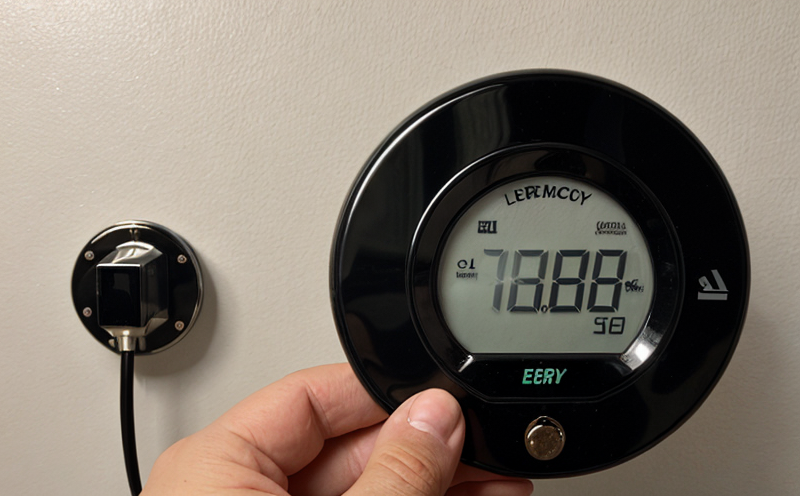IEC 61591 Energy Efficiency Testing for Range Hoods
The International Electrotechnical Commission (IEC) Standard IEC 61591 sets the benchmark for ensuring that range hoods are energy-efficient and safe to operate. This standard is critical for manufacturers, quality managers, compliance officers, and R&D engineers who aim to meet regulatory requirements and enhance product performance in today’s competitive market.
Range hoods equipped with advanced technology play a significant role in improving indoor air quality by capturing harmful pollutants generated during cooking activities. However, their energy consumption must be optimized to minimize environmental impact while maintaining functionality. IEC 61591 addresses these challenges by providing detailed test procedures that evaluate the energy efficiency of range hood products.
During testing, various parameters are considered to ensure compliance with international standards:
- Airflow Rate Measurement: The airflow rate is a crucial factor in determining how effectively a range hood captures and removes contaminants from the kitchen environment. Proper measurement ensures that the device performs optimally under different operating conditions.
- Sound Pressure Level (SPL): Noise levels generated by range hoods are also evaluated to ensure they do not exceed acceptable thresholds, thereby enhancing user comfort without compromising on performance.
- Energy Consumption: This parameter directly relates to the amount of electricity consumed during operation. Minimizing energy consumption is essential for reducing operational costs and promoting sustainability practices within households and commercial settings alike.
The testing process involves several steps which include initial setup, calibration of instruments, application of specified test conditions, data collection, analysis, and reporting based on predefined criteria outlined in IEC 61591. Compliance with these standards not only guarantees safety but also enhances brand reputation among consumers who increasingly prioritize eco-friendly solutions.
By adhering to the rigorous requirements set forth by IEC 61591, manufacturers can confidently introduce innovative range hood models into markets worldwide, ensuring they meet stringent quality expectations. This standardization fosters trust between producers and purchasers while driving technological advancement towards more efficient appliances.
In summary, conducting thorough energy efficiency tests according to IEC 61591 ensures that range hoods not only function effectively but also contribute positively toward conserving natural resources and protecting public health. As sustainability remains a key focus area across industries, implementing such standards becomes increasingly important for maintaining competitive advantage.
For those looking to ensure their products comply with this standard, our laboratory offers comprehensive testing services tailored specifically to meet the needs outlined in IEC 61591. Contact us today to learn how we can assist you in achieving regulatory compliance and enhancing your product offerings.
Benefits
Compliance with IEC 61591 offers numerous advantages for manufacturers, distributors, and consumers alike. Here are some key benefits:
- Increase Market Access: Meeting the stringent requirements of international standards opens doors to global markets where these certifications are recognized.
- Better Consumer Perception: Products that meet or exceed IEC 61591 guidelines tend to be perceived as superior in terms of quality and reliability, leading to increased customer loyalty.
- Sustainable Development: By focusing on energy efficiency, manufacturers contribute significantly towards reducing carbon footprints associated with appliance usage.
- Enhanced Product Reputation: Certification according to IEC 61591 can elevate brand image and position companies as leaders in responsible innovation.
In addition to these immediate benefits, compliance fosters long-term relationships with regulatory bodies, which is crucial for ongoing success in any competitive industry. It also provides a foundation upon which continuous improvement efforts can be built, ensuring sustained excellence over time.
International Acceptance and Recognition
IEC 61591 enjoys widespread recognition across numerous countries due to its robust framework addressing both technical specifications and safety considerations. Many jurisdictions around the world have adopted this standard as a benchmark for assessing energy efficiency in domestic appliances like range hoods.
The United States, Canada, Europe (via harmonization with EN standards), Australia, New Zealand, and other regions recognize IEC 61591 as authoritative guidance. Compliance contributes to meeting local regulations such as ENERGY STAR certification or the European Union's Eco-design Directive.
International acceptance extends beyond mere compliance; it signifies adherence to globally accepted best practices in environmental protection and resource conservation. This standardization facilitates seamless trade between nations, streamlining processes for importers/exporters while promoting fair competition among suppliers worldwide.
Given the growing emphasis on sustainability, countries are increasingly aligning their policies with international standards like IEC 61591 to ensure consistency in quality and performance metrics. As a result, obtaining certification according to this standard enhances product attractiveness not just domestically but internationally as well.
Use Cases and Application Examples
IEC 61591 applies specifically to range hoods intended for residential or commercial kitchens. The scope includes all types of ventilation systems designed to capture cooking fumes, odors, and particulates while minimizing noise levels. Here are some practical applications:
- Residential Kitchen Ventilation Systems: Ensuring that range hoods installed in homes comply with IEC 61591 helps maintain indoor air quality by effectively removing contaminants.
- Commercial Kitchen Ventilation Equipment: For large-scale operations such as restaurants and hotels, compliance guarantees peak performance without unnecessary energy waste.
The testing procedures outlined in IEC 61591 cover multiple aspects including airflow rates, sound pressure levels, electrical efficiency ratings, and more. These comprehensive evaluations help identify areas for improvement in existing designs while providing direction for future innovations aimed at optimizing energy usage.
Manufacturers often use these tests as a starting point when developing new products or making modifications to existing models. By adhering strictly to the guidelines provided by IEC 61591, companies can ensure that their range hood solutions meet global standards while maintaining high levels of user satisfaction through superior functionality and reliability.
Our laboratory offers specialized testing services aligned with these requirements, helping clients achieve compliance efficiently and cost-effectively. Whether you're looking to validate existing models or develop cutting-edge prototypes, we provide the expertise needed to navigate complex regulatory landscapes successfully.





